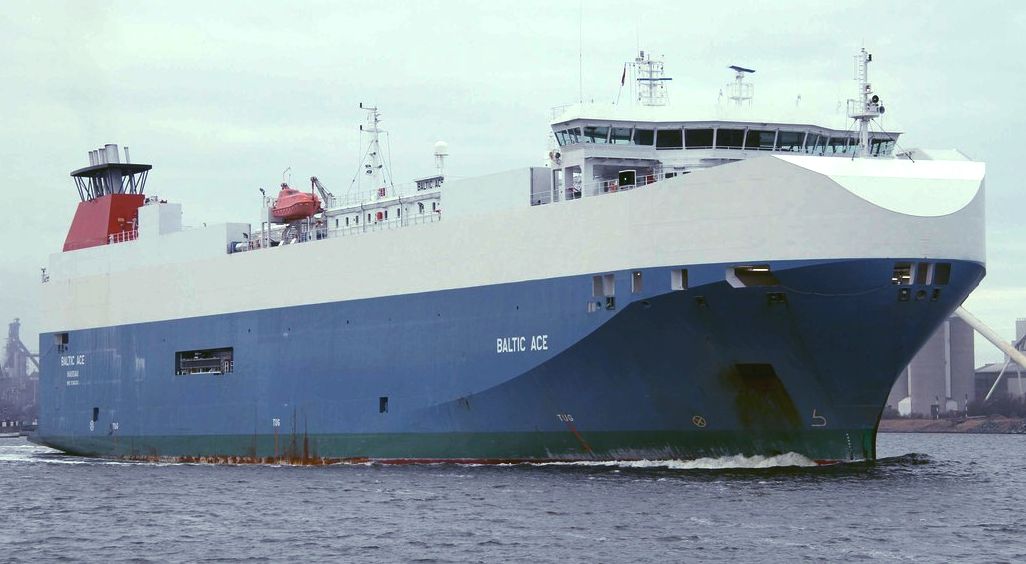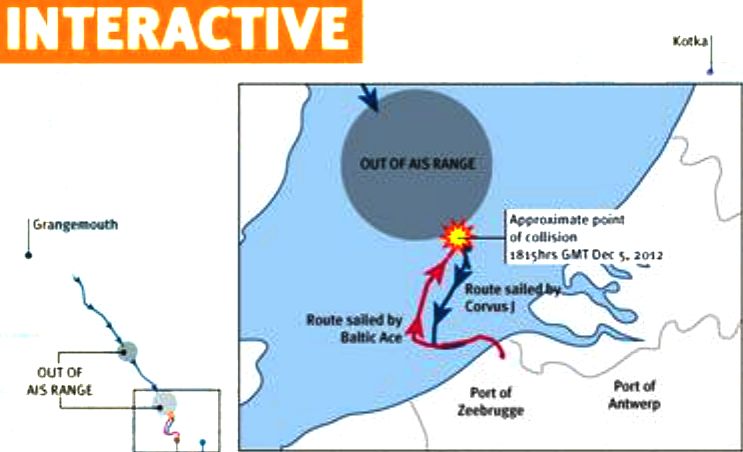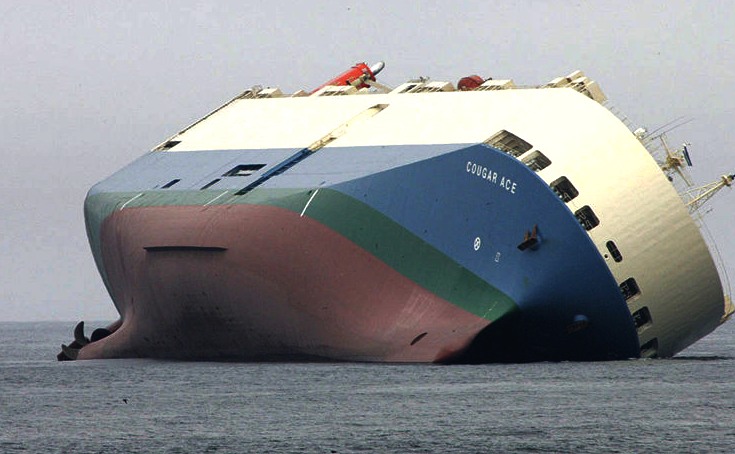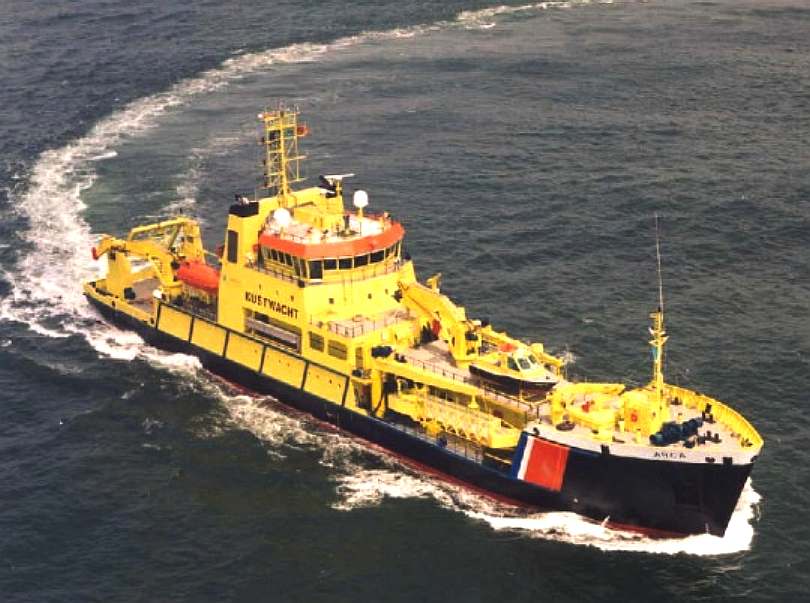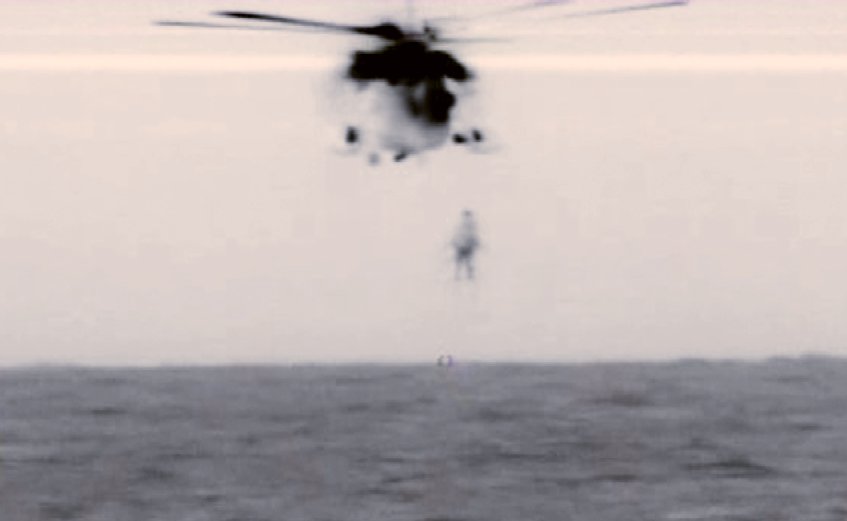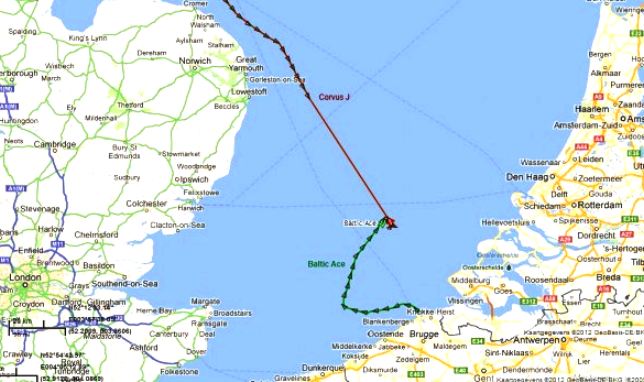"The water temperature was then seven to eight degrees. How long can someone withstand such conditions and survive? From half an hour to an hour,"
Peter Boyen, one of the rescuers from the Dutch Coast Guard, told Polish Radio.
Panagiootis Kakoliris, operations manager at Stamco Ship Management, which managed the Baltic Ace, told
Reuters that the ship was only five years old, and weather conditions at the time of the collision were "normal" and that "human error" was probably to blame.
Dutch coastguards have called off a search and rescue operation after the sinking of the Baltic Ace cargo ship in the North Sea.
A fifth body was found on Thursday and 13 people were rescued on Wednesday, but six more of the ship's 24-man crew remain missing following the collision with a container ship.
The Balctic Ace, a car carrier flying under a Bahamas flag, sank after coming into contact with the Corvus J, a container ship from
Cyprus.
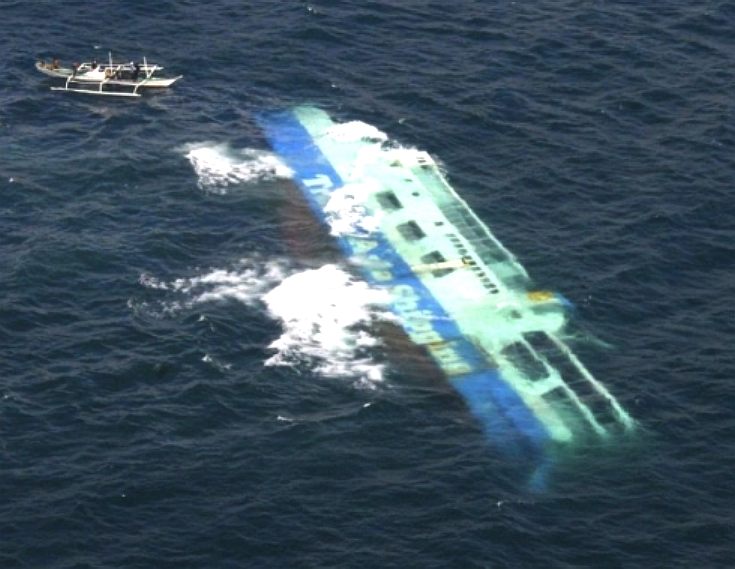
Sinking
ship doomed
AMSTERDAM Thu Dec 6 (Reuters)
Human error was probably to blame for a collision that killed five crew and sank the Baltic Ace car carrier, its Greek manager said on Thursday, and Dutch rescuers said it was unlikely six missing seamen would be found alive.
The Dutch Defence Ministry said conditions were treacherous when the Corvus J container ship and the Baltic Ace collided, sending 1,400 new cars, mostly Mitsubishis from Japan and Thailand, to the seabed on Wednesday evening.
But Panagiootis Kakoliris, operations manager at Stamco Ship Management Co., Ltd. which managed the Baltic Ace, told Reuters sea conditions were normal when the 23,500-tonne ship was lost.
The cause of the crash, which killed two Poles, two Filipinos and a Ukrainian, was unclear.
Kakoliris said technical failure was extremely unlikely because the ship was just five years old, in very good condition and had passed a safety inspection in August.
"We had a very violent collision which was the reason for the quick sinking of the vessel," Kakoliris said. "It was most probably hit in the side and that's why water entered in huge quantities with this result.
"You cannot control some things. This happened in good weather, normal weather. There was good visibility, so I feel most probably there was a human error," Kakoliris said. He did not say who he thought was responsible for the collision.
It was not known if the Polish captain, who was released from a hospital, had spoken to authorities about the collision 50 nautical miles from Rotterdam, Europe's largest port.
The owners of the Corvus J, German shipping firm Juengerhans, did not discuss responsibility for the collision in a statement published on its website. It said it would "offer its full cooperation into the investigation."
"The only thing we know from the crew is that there was a wind force of 6-7 out on sea," a company spokesman said, adding that was not unusual for the time of year.
The car carrier, built in 2007, sank in 15 minutes. The wreck is now at a depth of about 25-30 meters near the Noord Hinder shipping route, one of the busiest in the world.
Ref:
A Deutsch & T Escritt
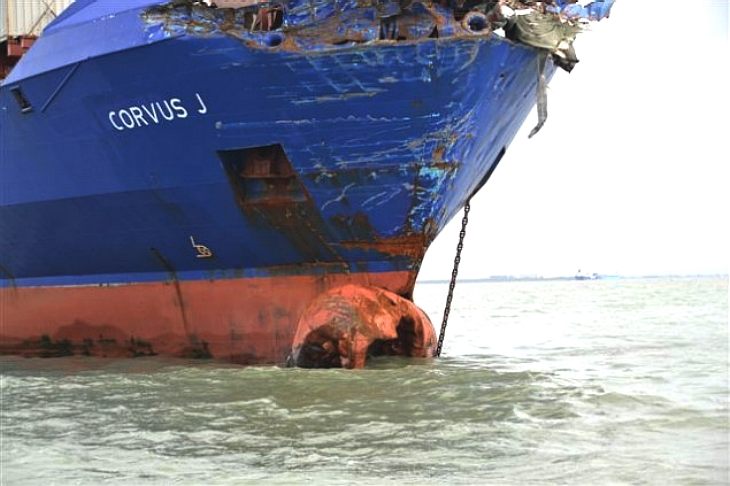
NO DUTCH JURISDICTION
Dutch authorities said they would not launch a criminal investigation because the accident took place outside their territorial waters and neither of the ships was Dutch.
Cyprus and the Bahamas could still ask the Netherlands to investigate through bilateral requests.
The Dutch coastguard said cold, snow, three-meter-high waves and gale-force winds meant there was only a slim chance of finding alive any of the missing crew, who included a Bulgarian.
The coastguard said 13 of the 24 crew were rescued on Wednesday after survivors scrambled into life rafts and were winched to safety by helicopters, or picked up by ships.
Karen Gelijns, a spokeswoman for the Dutch Defence Ministry, said: "It was a wild night, there were force 6 winds, very rough seas, and it was snowing." Gelijns said the ship sank so quickly "nobody would have had time to put on protective clothing".
SHIPPING TRAFFIC UNAFFECTED
The Baltic Ace was en route from Zeebrugge in Belgium to Kotka in Finland, while the Corvus J was going from Grangemouth in Scotland to Antwerp, Belgium.
Officials said the Corvus J was damaged and resumed its route to Belgium. No delays were caused to shipping traffic in Dutch waters, where about 250,000 vessels pass each year.
"It is very busy route," said Edwin de Feijter, a spokesman for Rijkswaterstaat, a directorate whose responsibilities include the shipping lanes in the Dutch part of the North Sea, adding that the ship sank near rather than in the route.
The Baltic Ace was managed by Stamco Ship Management Co. Ltd., based in Piraeus, Greece, and owned by Isle of Man-based Ray Car Carriers. It was insured for between $50 million and $60 million, two sources said.
Insurance Insider said the loss caps a difficult year for the marine insurance sector including $1.16 billion in claims from the cruise ship Costa Concordia and $2 billion to $3 billion in losses from Hurricane Sandy.
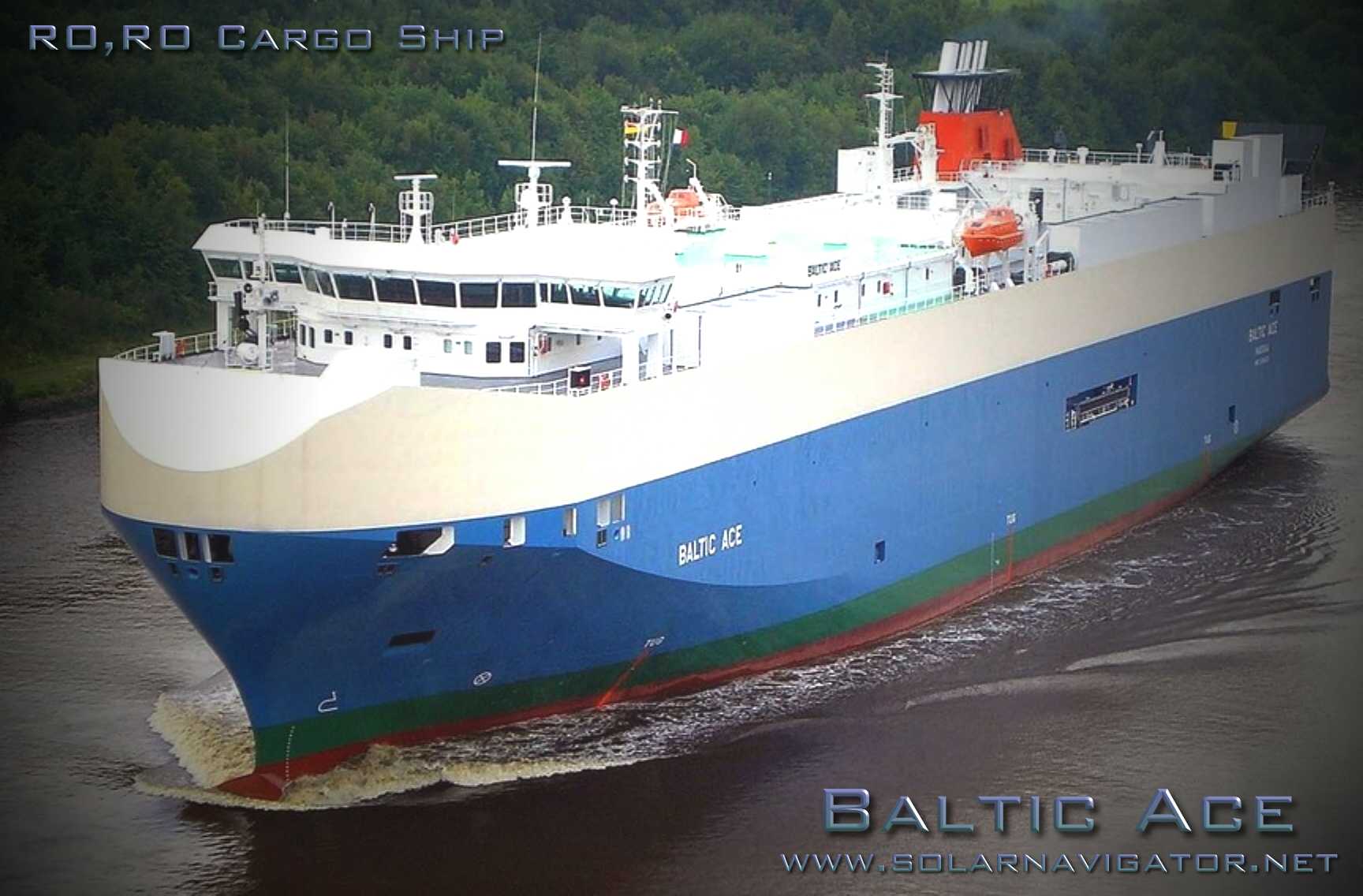
ARE RORO's SAFE AFTER THE HERALD OF FREE ENTERPRISE AND NOW THE BALTIC
ACE?
Equipped with built-in ramps and long tiers of decks, Roll On Roll Off (RoRo) ships are essentially floating parking garages that allow vehicles to be driven aboard the ship at the loading port and driven off at another. The use of the vehicles’ own wheels makes loading RoRos much faster and more effective than traditional ships which require massive cranes to unload.
RoRo’s are certainly efficient but, the question remains, are they safe? The truth is that the most tragic RoRo incidents – like the 1987 Herald Of Free Enterprise disaster which claimed 193 lives, the 1994 M/V Estonia tragedy which claimed 852 lives, and yesterday’s sinking of the Baltic Ace – are only exclamation points on less tragic losses like that of the M/V Cougar Ace and M/V Tricolor.
History
Modern RoRo ships can trace their origins back 100 years to the early days of the steam locomotives. Back then, ships were designed to take trains across rivers which were too wide for bridges: the ships were equipped with rails, and the trains simply rolled straight on to the ship, which sailed across the river to another rail berth where the train would roll off again. An example is the Firth of Forth ferry in Scotland, which began operations in 1851.
It was not until the Second World War however, that the idea of applying the RoRo principle of road transport became practical – and was used in constructing the tank landing craft used at D-Day and in other battles. The principle was applied to merchant ships in the late 1940s and early 1950s. It proved to be extremely popular, especially on short-sea ferry routes.
For the shipper, the RoRo ship offered a number of advantages over traditional ships, notably speed. As the name of the system implies, cars and trucks can drive straight on to a RoRo ship at one port and off at the port on the other side of the ship within a few minutes of the ship docking.
But why are they so dangerous?
On conventional ships, the hull is divided into a number of separate holds by means of transverse bulkheads, many of which may be watertight. In the event of the hull being holed, the bulkheads will limit or delay the inrush of water, resulting in the ship sinking slowly enough for the evacuation of those on board or even preventing the ship from sinking at all. In addition, these transverse bulkheads and compartments limit something called the “Free Surface Effect” which is a huge contributor to a loss of vessel stability.
Having wide open spaces on a ship with only an inch of water on the deck can create a serious problem with regard to vessel stability. RoRos are particularly subject to this dilemma due to their large open cargo areas and coming up with the right solution to mitigate this issue is one of the top challenges a
naval architect might face when designing such a vessel.
Another problem is freeboard, the height of a ship’s side between the waterline and the deck. Cargo access doors fitted on cargo-only (passenger RoRos are now subject to stricter regulations) RoRos are often very close to the waterline. These access doors (often located at the stern and bow of a RoRo) can become damaged or twisted during a collision, especially when the door also serves as a ramp.
Another problem is that the movement of cargo on the vehicle deck can affect the stability of the ship, causing it to list. The sudden inrush of water following a collision can cause vehicles to break loose from their lashings and pile up on the low side of a capsized ship. Even a moderate list can cause cargo to break loose if it is not correctly stowed and secured.

Perilous Escape
All of the above factors can shorten the amount of time that the crew has to escape a RoRo before she sinks but, once the alarm is given, abandoning a RoRo that is listing can be dangerous. In 2006 the crew of the RoRo vessel Cougar Ace was able to escape the ship after she experienced ballast problems in Alaska but, because of the 60-degree list, a member of the salvage team slipped and fell to his death on the vessel’s upper deck.
Even if the crew can maneuver themselves across a heavily listing deck, the high sides of many modern RoRo’s pose another problem: the higher a lifeboat is stowed above the waterline the more difficult it can be to launch, especially if the ship is listing badly.
These factors indicate that RoRo’s are highly sophisticated ships which require very careful handling. This makes them exceptionally vulnerable to human error.
In Defense of RoRo’s
While many experts agree that RoRo’s are dangerous, in 2004, more than 1.3 billion passengers, 188 million cars, 856,000 buses and 28.7 million trailers were carried on 5.9 million crossings globally and non-passenger carrying RoRo’s, like the Baltic Ace, have a similarly impressive safety record in recent years.
As of this moment little is certain about the cause of the tragic Baltic Ace incident, but one thing is certain: the industry’s best minds will continue to focus on improving regulations to make ocean transport safer.
Ref:
JK
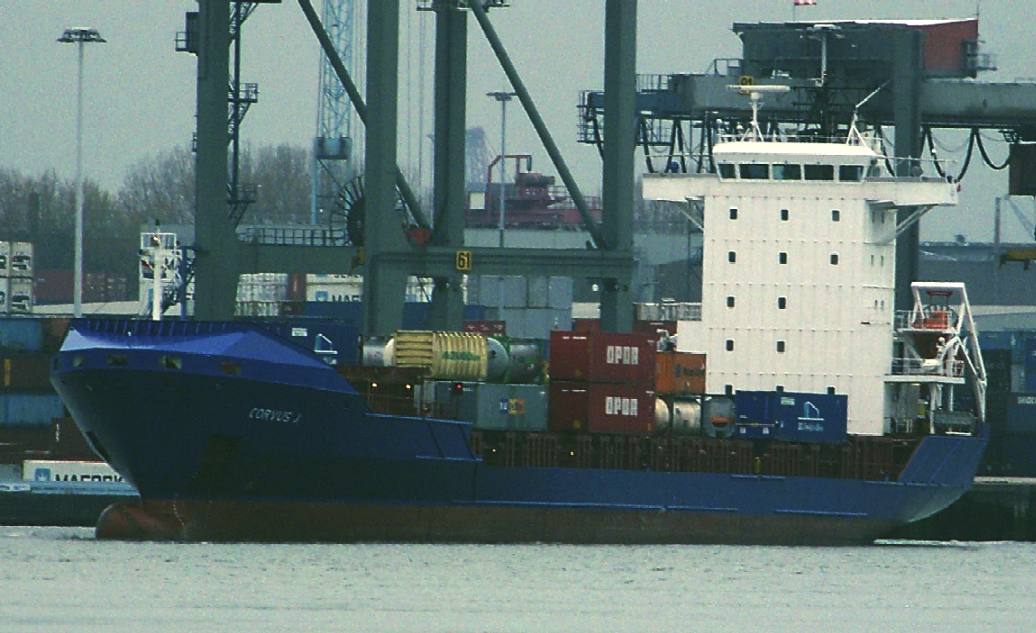
Hollanda'nın Zeeland sahiline 65 kilometre uzaklıkta Kuzey Denizi'nde, "Corvus J" adlı konteynır gemisiyle çarpıştıktan sonra batan yük gemisindeki mürettebatın 4'ünün öldüğü, 7sinin kayıp olduğu
bildirildi.
Hollanda yayın kurumu NOS, Belçika'dan Finlandiya'ya araba taşıyan Bahama bandıralı Baltıc Ace adlı yük gemisindeki mürettebatın 13'ünün sahil güvenlik ekipleri tarafından kurtarıldığını ve bunların 4'ünün Erasmus Üniversitesi Tıp Merkezi'ne kaldırıldığını duyurdu. Mürettebatın 4'ünün ise öldüğü, 7'sının kayıp olduğu açıklandı.
Bölgeye, içinde donanmaya ait iki gemi, bir uçak ve helikopterlerin de yer aldığı kurtarma ekiplerinin gönderildiği, şiddetli rüzgarın ise kurtarma çalışmalarını olumsuz etkilediği
belirtildi.
DUTCH OIL SPILL RESPONSE
The Dutch government’s hydrographic and oil spill response vessel, M/V Arca, has left the scene of the Baltic Ace and has been replaced with the hydrographic research vessel Zirfaea, which is also government owned. For now the Zirfaea will stay in the area to guide traffic around the vessel. Buoys still mark the wreckage, which rests 6 meters below the surface in a high traffic area just south of the start of the Eurogeul, a deep water channel leading to Rotterdam.
Yesterday, gCaptain reported that the Baltic Ace had 466 tons of heavy fuel oil and 55 tons of marine diesel on board when it sank. These number have been confirmed by a spokesman for Svitzer, the company hired to remove the fuel oil. We have also been told that preparations started over the weekend.
“This week the dive support/stand-by vessel VOS Statisfaction arrived in Ijmuiden, she will be the base ship during the oil removal. We hope our divers can start inspections this week, but it’s a tricky spot with a lot of traffic and severe weather impact.”
Then on the operation itself:
“Two options to get the oil out are connecting lines to the existing bunker system or create new pipelines that connect with the oil tanks. Other recovery methods are also possible, it all depends on the findings of the divers. Svitzer will also try to remove other oils such as lubrication oil, but whether this succeeds depends on the accessibility of the storage tanks. After inspection the operation will take about 2 to 4 weeks.”
Once the oil is removed, then salvage can begin.
“For now Svitzer is only doing the recovery and removal of oils. Who will do the actual salvage of the vessel is not known yet,” the spokesman added.
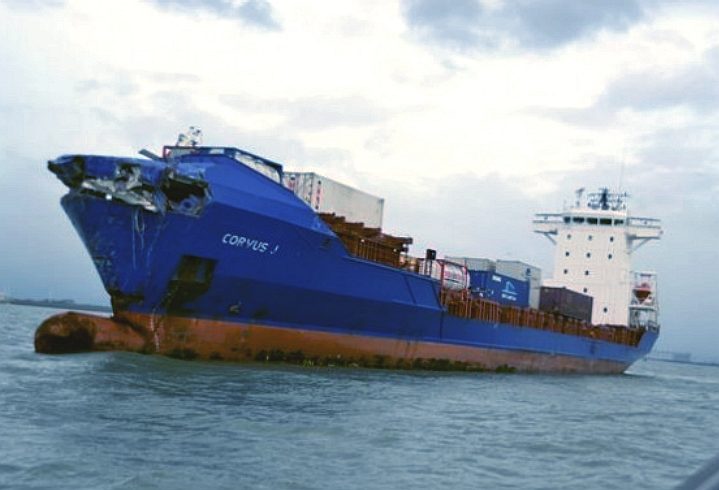
CORVUS J
The M/V Corvus J is a modern, 8,370 dwt container-feeder-vessel with the capacity for 630 TEU. The vessel has a length of 134m and a breadth of 19.4m and operates in European
container feeder services. It was built on the “Rolandwerft” in Berne,
Germany in 2003.
The vessel is currently at flushing anchorage awaiting further instructions from Dutch authorities, according to a statement from the ship’s owner, Jüngerhans Maritime Services GmbH & Co. KG of Germany. The statement continued:
"All our thoughts and condolences go out to the families of those crew members who have been lost in this tragic accident and to those who are still missing. Juengerhans understands that the search and rescue operation was resumed early this morning and it is our sincere hope that further survivors will be found."
DUTCH AUTHORITIES MV ARCA 7 December 2012
At the scene of the collision is the Dutch government-owned hydrographic research and oil spill response vessel M/V Arca. Arca’s crew has placed five cardinal buoys at the scene marking the location of the wreck. The vessel will stay at the scene to ensure safe traffic near the Baltic Ace.
The wreck forms an immediate danger to traffic. The vessel sunk in an incredibly busy area, just south of the beginning of the Eurogeul which leads to the port of Rotterdam. According to Mariska Verbeij, spokeswoman of the Dutch Ministry of Infrastructure and the Environment, the Arca has conducted a small survey using it’s multi beam echo-sounder. “Due to bad weather conditions and limited amount of water above the wreck a more detailed survey using an external echo-sounder (called ‘the fish’ by the vessels crew) could not be conducted. But the images we’ve obtained so far show the vessel is intact.” The water depth at the scene is 36 meters, and there is only 6 meters of
water between the Baltic Ace and the surface. This afternoon, the Dutch Coastguard announced that the Arca will stay at the scene, at least until this coming Monday. “On Monday a new assessment will be made deciding
whether or not the Arca will have stay longer to guide traffic at the scene”, a spokesperson said.
The Dutch Ministry of Infrastructure and the Environment maintains contact with Baltic Ace owner Baltic Highway Piraeus regarding the salvage of the ship. “We are waiting for the owner to come up with a plan for salvaging the vessel, but this usually takes time.” Smit Salvage has offered ‘to help with the salvage of the Baltic Ace. “We’ve had contact with the insurance company and the owner of the vessel”, press officer Martijn Schuttevaer of Boskalis-Smit Salvage says. “With these kind of accidents the first to steps are the search and rescue of crewmembers and the removal of all oils within the ship. We are waiting for the Dutch government to decide wether they find salvage of the vessel necessary or not.”
On board the Baltic Ace were 1417 cars of the brand Mitsubishi. Some Dutch media report rumors that there were also some
ferrari’s,
Bentley’s,
Rolls Royce’s and
Lamborghini’s on board.
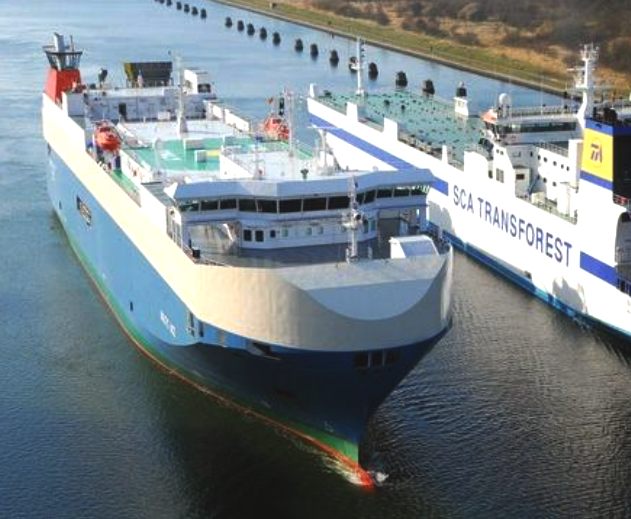
FRACHTER
'BALTIC ACE' NACH KOLLISION GESUNKEN
Amsterdam. Ein schweres Schiffsunglück hat in der Nacht vermutlich elf Opfer gefordert. 13 Seeleute des Autotransporters
"Baltic Ace" konnten gerettet werden. Vier Seeleute wurden in der Nacht tot geborgen. Nach sieben Besatzungsangehörigen wurden bis 2 Uhr in der Nacht gesucht. Die Suche soll heute früh fortgesetzt werden.
Das Unglück ereignete sich am Mittwochabend gegen 19.20 südwestlich von Rotterdam in einem vielbefahren Seegebiet. Unmittelbar nach dem Zusammenstoß mit dem Containerschiff
"Corvus J." ist der Autotransporter "Baltic Ace" am Abend gesunken. An Bord des Havaristen befanden sich nach Angaben der niederländischen Küstenwache 24 Seeleute. Von ihnen wurden bei stürmischer See 13 Seeleute gerettet und von Hubschraubern nach Oostende und Rotterdam gebracht.
Nach elf vermissten Besatzungsmitgliedern wurde nach Mitteilung der Königlich Niederländischen Küstenwache mit einem Großaufgebot an Handelsschiffen gesucht. Bis Mitternacht wurden dann vier Leichen von Hubschraubern geborgen. Ein toter Seemann wurde von einem niederländischen Seenotrettungsboot aus dem Wasser gezogen.
Die Kollision hat sich etwa 65 Kilometer vor der niederländischen Küste bei Goere in einem Seegebiet ereignet, wo sich die Seewege für die Schiffsverkehre zum Ärmelkanal und nach Rotterdam sowie Antwerpen kreuzen. Sofort nach dem Unglück konnten zwei Seeleute der sinkenden
"Baltic Ace" von dem Kollisionsgegner gerettet werden. Elf Schiffbrüchige retteten niederländische und belgische Hubschrauber.
An der Suchaktion waren über 20 Schiffe und drei Hubschrauber bis 2 Uhr beteiligt. Zusammen mit vier Rettungskreuzern suchten auch die Patrouillenboote
"Holland" und "Groningen" der niederländischen Marine und mehrere Fischer und Handelsschiffe das Seegebiet ab. Darunter auch der Hamburger Tanker
"Christian Essberger" und der Schwergutfrachter "Panagia" aus Haren an der Ems.
Die 148 Meter lange "Baltic Ace" war mit einer Ladung Neuwagen auf dem Weg von Zeebrügge (Belgien) nach Kotka. Die zur Flotte der deutschen Reederei Jüngerhans gehörende „Corvus J.“ befand sich auf dem Weg von Schottland nach Antwerpen. An Bord des 130 Meter langen und 2003 gebauten Containerschiffs „Corvus J“ kam niemand zu Schaden. Der Frachter beteiligte sich bis zum Morgen an der Suche nach den Vermissten Seeleuten.
LINKS
www.collisionregs.com/Collregs.html
www.cbsnews.com
costa concordia salvaging a shipwreck
www.mirror.co.uk
costa concordia captain wasnt wearing his glasses
http://cruisemiss.com/2012/05/20/costa-concordia-year-long-refloat-operation/
http://www.marinetraffic.com/ais/shipdetails.aspx?mmsi=309474000
http://www.safety4sea.com/page/14213/5/no-hope-of-finding-more-survivors-after-baltic-ace-sinks
http://www.reuters.com/article/2012/12/06/us-dutch-ship-collision-rescue-idUSBRE8B514E20121206
http://www.bbc.co.uk/news/world-europe-20616997
http://www.denizhaber.com/HABER/31326/4/baltic-ace-kuzey-denizi-kaza.html
http://gcaptain.com/svitzer-starts-preparations-on-sunken-baltic-ace/
http://gcaptain.com/corvus-j-containership-damage-photos/
http://gcaptain.com/baltic-ace-update-search-ends-dutch-media-pounces/
http://www.lloydslist.com/ll/countries/Netherlands/
http://www.msnbc.msn.com/id/44406912/ns/business-north_sea?q=North%20Sea
http://www.kn-online.de/In-Ausland/Panorama/Frachter-Baltic-Ace-nach-Kollision-gesunken
http://www.skyscrapercity.com/showthread.php?t=987081&page=2

Solarnavigator
is designed to carry the Scorpion
anti pirate weapon. A fleet of such autonomous vessels could be the basis
of an international peacekeeping, and/or emergency rescue force.
The
navigation system that is being developed for SolarNavigator could have
prevented the sinking of the Costa Concordia. This might be of interest
to fleet operators.
